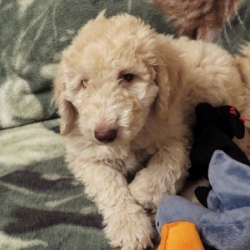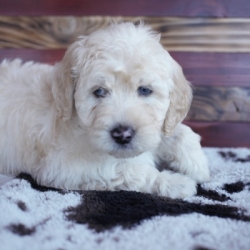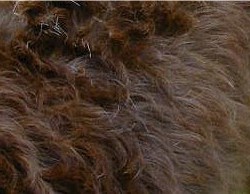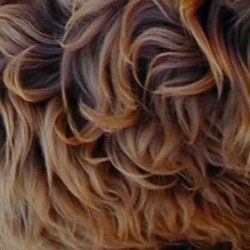


A compact dog, not exceptionally boxy nor long bodied. A galloping dog which gives the impression of light footed athleticism, and joyful bearing. Medium to light boning, graceful in movement and with vivacious expression. Coat should be non shedding, grow in an even length over body, on legs neck, tail and head, and should be as close to non allergenic as possible. Their unique traits of intuitive nature and the seeking of human eye contact should be easily discernable at a glance. Easily amenable to training.
Confident, joyful, vivacious, clown-like, sociable and friendly. Totally non aggressive, clever and extremely intuitive. Well suited for special work such as Therapy Dog, Assistance Dog, Hearing or Seizure Alert Dog, Guide Dog. Can try to outsmart their Owners just for fun, if not firmly disciplined when young. Respond well to positive Training methods. Loyal and devoted to family. Most love water and are natural Swimmers and retrievers. Affectionate and loving. Active and athletic when free, but should ‘melt’ into mellowness when touched by human hands.
Disqualifying Temperament Faults – Timidity, (not environmentally induced) hyperactivity, aggressiveness to either people or other animals, are all serious disqualifying faults and dogs exhibiting these traits should not be bred from.
Currently there are three sizes of Labradoodles.
Miniature range:Â Height: 14 to 16 (not over 17) inches (35cm to 42cm) at wither.
Medium range:Â Height: 17 to 20Â (not over 21) inches (43cm to 52cm) at wither. The ideal size for the female is 17 to 19 inches and the male is 18 to 21 inches.
Standard range:Â Height: 21 to 24 (not over 25) inches (53cm to 63cm) at wither. The ideal size for the female is 21 to 23 inches and the male is 22 to 24 inches.
* SIZES ARE SUBJECTIVE – One persons idea of “MEDIUM” is another person’s idea of “SMALL” etc.
Head: Moderately broad with well-defined eyebrows. Stop should be moderate with eyes set well apart. The head should be of moderate width; developed but without exaggeration. Fore-face to appear shorter than skull. The head should be clean-cut and free from fleshy cheeks. The whole head must be in proportion to the size of the dog. The head should be in proportion to the rest of the body, being neither blocky, nor too fine or chiseled. Medium stop, length from nose to eyes should be only slightly longer than length from eyes to occiput. Skull should be slightly rounded but not domed. Forehead medium breadth, muzzle not snipey, but should have depth and breadth. Weak underjaw is a fault. The head should flow naturally into a strong slightly curved and muscular neck and not appear to be ‘stuck on’. Long narrow or ‘Poodley’ head is a fault.
Eyes:Â Should be wide set, large and expressive, lustrous or sparkling, oval to round, and must not bulge (as in the Pekinese for example). Expression to be lively, curious, wise, full of fun and with an intuitive expression, seeking contact with human eyes. A sharp, piercing or expressionless eye is a serious fault.
Eye colors can be darkest brown, a transparent honey color, or shades of hazel. Protruding eyes, sunken or watery eyes are a fault. (note that puppies may sometimes have tear stained eyes during teething). Odd colored eyes (each a different color to the other) is a serious fault. Marble eyes such as are found in Blue Merle dogs is a serious fault.
A feature of the eyes is their very long eyelashes which should never be cut. They provide a ‘verandah’ to help keep the long coat out of the dog’s eyes.
Ears: Low on the head and can not stick up or out. Set slightly above eye level and should lay flat against head in proportion with the skull. Leather should be of medium thickness, and leather should not hang below the lower lip line. Excessive hair in the ear canal is undesirable.
Mouth: Must be a scissor bite. Upper teeth to just overlap the bottom teeth. Scissor bite, meaning that the upper teeth fit closely over the tops of the lower teeth. Gaps between upper and lower teeth are a fault. Undershot mouths (where the lower teeth extend beyond the upper teeth) are a fault. Overshot mouths (where the upper teeth extend beyond the lower teeth) are a fault. Level bite, (where the biting edges of teeth meet but do not overlap) are a fault but not a serious fault. Crowded teeth in the adult dog are a fault especially in Miniatures.
Nose:Â Should be large, of square appearance and fleshy. A definite feature. Large square and fleshy in appearance. Must never be small, pinched, narrow or pointed.
AN EXAMPLE OF ROSE(LIVER) PIGMENT AND “GHOST EYES” (GREEN,AQUA)
Neck:Â Well proportioned of good strength, moderately long lending an air of elegance, slightly arched and flow into shoulders with no appearance of abruptness.
Forequarters:Â Shoulders blades and upperarms to be the same length, and shoulders should be well laid back. Elbows are set close to the body. Forelegs to be straight when viewed from the front. Toeing in our out is a fault.
Body: Height (to wither) as to length (from sternum to point of buttock) should appear square and compact. Deep chest and well sprung. There should be a good tuck up. Loins should be strong and muscular. Height to length ratio should be as ten is to twelve, being slightly longer in leg than deep in body, but still looking compact. Level top line, strong over loins and slightly sloping croup and with sloping shoulders flowing into firm elbows and front legs straight to the ground. Straight upright shoulders are a fault as are straight stifles. Stifles should have medium angulation and be long, with short strong hocks parallel and straight to the ground. Cow hocks are a fault as are toes turning either inwards or outwards. They are a galloping dog, so flanks should rise to a medium tuck up, from a deep brisket and well sprung ribs.
Hindquarters:Â In profile the croup is nearly flat, slight sloping of the croup is acceptable. Stifles should be moderately turned to propel forward movement, and hindquarters well muscled for power in movement. Hock to heel should be strong and short being perpendicular to the ground. View from the rear should be parallel to each other, must not be cow-hocked.
Feet: The feet are of medium size, round with well-arched toes having elastic and thick pads. The feet should not turn in or out. Foot pads should be thick and deep and close together. Weak ‘hare’s feet’ are a fault. There should be a definite ‘ankle’ between the feet and legs. Front dewclaws may be removed although it is not necessary. It is rare for an Australian Labradoodle to have hind dewclaws but if puppies are born with them they must be removed at four days old.
Tail: The tail should follow the topline in repose or when in motion. It may be carried gaily, but should not curl completely over the back. Tip of tail should not touch the back nor curl upon itself. Ideally saber shaped as in the Labrador Retriever. But during the formative years of this breed the tail may be carried gaily and swirling over the back. Tightly curled teapot tails are a fault. Kinked tails are a fault. Tails must not be docked.
First impression should be of a dog whose feet seem to hardly touch the ground. Light, lithe, graceful and athletic. When trotting, should have the appearance of ‘going somewhere’ with energy and effortless drive and purpose. Looking like they are dancing and ballerina-like in motion.
When galloping, they should appear to float almost above the ground. Light and airy, flowing and free moving with a complete absence of apparent effort.
A distinctive feature of this breed is that the coat is non-shedding and easily maintained. Any coat length is acceptable but preferable not past 4 inches in length. The coat should be even over the entire body. It should be straight, wavy or forming spirals. It should not be too thick or dense, nor should it be fluffy or fuzzy. It should be a single coat. Any sign of an undercoat is a serious fault. Can range between a fleece to wool in texture. Extremely harsh hair is highly undesirable.
 |
 |
 |
|
Hair |
Fleece |
Wool |
|---|
The Hair Coat (Dog hair texture either feathering, scruffy, or wavy) is a coat that is more likely to shed (a little but nothing like a Lab) and will need a quick brushing/combing about once a month depending on the density and length of the coat. NEVER shave your hair coat’s body. A light trimming might be required with scissors but usually not. The hair coat is usually only seen with the first generation (F1) Labradoodles.
 The Normal Fleece Coat (Soft Angora type texture wavy or loose spiralling coat) is an allergy and asthma friendly coat and will need to be brushed/combed thoroughly about every two-three weeks. This coat usually requires trimming one-two times a year.
The coat is always a single coat with a definite absence of fluffy undercoat. Whether Fleece or Wool the coat must not shed and must be allergy friendly to the vast majority of persons with dog related allergies. It must have no doggy odour. The coat is one of the unique features of this breed and must be a priority coming close behind physical health and sound temperament.  A ‘change’ of coat is permissible from puppy to adult and due to hormonal changes in entire females. With the exception of the hormonal shedding, this should not shed itself out, but needs to be stripped out with grooming. They have a distinctly soft fleecy ‘feel’ like no other dog coat &  should be a single coat, with a complete absence of fluffy undercoat. Ideally it should not be too thick, not dense nor fuzzy, but should hang in loose loopy spirals similar To that of the angora goat. Length is around four to six inches, on body, tail, head and face and on the legs.

The Curly Fleece Coat grows into spirals much like braided hair in humans and is also a single coat with no fluffy undercoat. When clipped short it should not grow back as curly as the Wool Coat.
The Wavy Fleece Coat is the ultimate coat type. Single coat with absence of fluffy undercoat. As puppies they are not as ‘pretty’ as their curlier litter mates but mature into stunningly beautiful dogs with easier maintained coats.
Straightish and only slightly wavy as puppies more curl develops until the coat is a long swinging curtain of loose slightly wavy tendrils. When clipped off short the coat should not grow back curly.
The Micro Fine Fleece Coat (Supper soft and fine texture in wavy or spiralling coat) is an allergy and asthma friendly coat, if kept well groomed. Because this coat is finer and softer if it gets mats that aren’t brushed out regularly eventually some of the mats will ball up into little “tumble weeds†and come out of the coat. It is recommended to thoroughly brush/comb this coat about once a week and don’t let the coat length to get past about three inches in length with trimming two to three times a year.

The Wool Coat (Dense curly coat with a lambs wool texture) has tight curls and feels similar to that of a pure bred Poodle.  This is an allergy and asthma friendly coat with the highest rate of success of the three coat types (Hair/Fleece/Wool). It will need to be brushed/combed thoroughly about once a week. This coat also requires trimming about three-four times a year.
The Wool Curly Coat will often be very dense and it should be the breeders’ goal to breed a looser curl than that of the Poodle in the interests of lower maintenance.
The coat should not appear overly groomed and any appearance of sun bleaching is acceptable.
Coat patterns in the Labradoodle include the following: All solid colours. Colours of Parchment, Lavender, Cafe’ and Chocolate may have dark amber eyes; liver noses, eye rims and lips; and dark nails. Colours of Caramel may have dark amber to pale hazel-green eyes; liver noses, eye rims and lips; and self coloured to dark nails. Colours of Gold, Red, Black, Blue and Silver must have very dark eyes; black noses, eye rims and lips; and black or self-coloured nails. Colours of Chalk and Cream may have either pigmentation of dark amber to pale hazel-green eyes; liver noses, eye rims and lips; and self coloured to dark nails or very dark eyes; black noses, eye rims and lips; and black or self-coloured nails. These colours may appear in one of the following patterns:
Solid:Â Colour is solid and preferably even, preferably with no white markings. A small white flash no larger than 2.5cm in diameter can appear on the chest, feet or tail and is permissible. Even colours are preferred but natural colouration of the coat is not considered a fault.
Parti:Â Colour is fifty percent white, with spots/patches of any other solid colour. No set pattern is required but symmetrical markings on the head are preferred. Freckling of the solid colour in the white of the coat is acceptable but not encouraged.
Phantom:Â The body colour must be a solid colour with defined markings of a second colour as follows: above each eye, on the sides of the muzzle, on the cheek, on the underside of the ears, on the throat to forchest, or in a chin and forechest pattern, with a minimum second colouring on the feet preferably up the legs, and below the tail. Second colour in the inside of the leg and flank is also acceptable and should not be penalized. Markings are preferred to be clear and defined. Face markings of the second colour with the entire face coloured is acceptable, though not preferred, if the other required body markings are present. Any of the solid colours combination is acceptable.
Abstract:Â Any solid colour with the second colour being white, must have less than fifty percent white.
Sable:Â Black-tipped hairs on any solid colour, preferable even but no penalty for uneven pattern of ticking.
Brindle:Â Should have an even and equal distribution of the colours with layering of black hairs in regions of lighter colours (usually, chalk/cream/gold/red, cafe/lavender/parchment, or silver) producing a tiger-striped pattern.
Multi:Â Multiple colours or patterns, as in a phantom with large white Abstract markings, or a Parti pattern with Sable ticking etc…
Merle is NOT a color that is available in the American Labradoodle. The Poodle does NOT carry the merle gene nor does the Labrador Retriever. If you see a Poodle breeder claiming to have merle colored poodles please understand that there has been another breed in the pedigree to bring in this color. Pure bred Poodles do not come in merle.
SPECIAL ATTENTIONÂ must be directed to soundness in the Labradoodle, any sign of lameness is a disqualification
Page Resources:
[su_button url=”https://www.akc.org/breeds/poodle/breed_standard.cfm” style=”soft” background=”#2850b1″ size=”9″ radius=”round” icon=”icon: heart” desc=”Breed Standard”]Standard Poodle[/su_button]Â [su_button url=”https://www.akc.org/breeds/labrador_retriever/breed_standard.cfm” style=”soft” background=”#2850b1″ size=”9″ radius=”round” icon=”icon: heart” desc=”Breed Standard”]Labrador Retriever[/su_button]